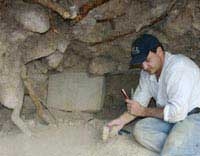Archaeologists in Spain have recently unearthed an eye-catching stone in a destroyed medieval tower.
A stone resembling a male phallus, measuring 15 cm in length, has been discovered among the ruins of a 15th-century medieval tower located near the mouth of the Ria de Vigo in northwestern Spain.

The phallic stone used in the Middle Ages for sharpening weapons. (Photo: ArboreArqueoloxía).
Immediately after the stone was found, a debate erupted among archaeologists.
Some believe this could be a remnant of an artistic sculpture, while others assert that it is a “personal item” of medieval warriors. According to this interpretation, it is essentially a sharpening stone used for honing weapons.
“This is certainly an intriguing object because of its unusual appearance,” said Dario Pena-Pascual, an archaeologist. “It seems to carry a symbolic connection between violence, weaponry, and masculinity—elements that still exist in our culture today.”
Pena-Pascual noted that sharpening stones are easily identifiable because they retain traces of the materials they interacted with. In this case, the object shows signs of wear on one edge, indicating it was used as a sharpening tool.
This interpretation seems the most plausible, as it depends heavily on the context where the stone was found. It was once a fortress destroyed during a rebellion against a lord’s authority.
According to Pena-Pascual, there have been many artifacts with similar appearances, but discovered in different locations, referred to by experts as “phallic symbols.” These objects are regarded as talismans, believed to protect their owners from evil, similar to many medieval items such as lamps, masks, pendants, and rings.





















































